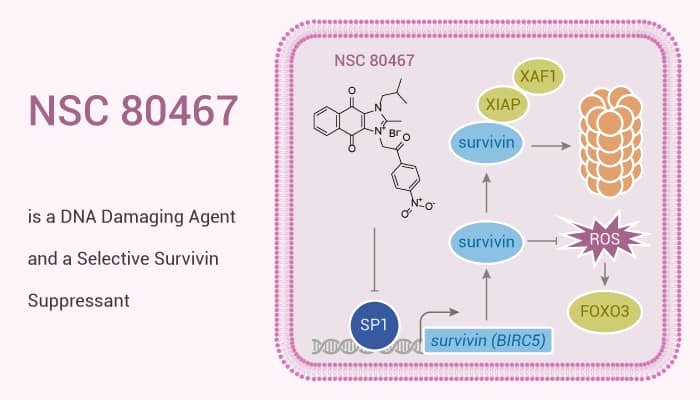Each of the ~1013 cells in the human body receives tens of thousands of DNA lesions per day. These lesions can block genome replication and transcription. If they are not repaired or are repaired incorrectly, they lead to mutations or wider-scale genome aberrations that threaten cell or organism viability. In addition, hydrolytic reactions and non-enzymatic methylations generate thousands of DNA-base lesions per cell per day.
Some DNA aberrations arise via physiological processes. To combat threats posed by DNA damage, cells have evolved mechanisms – collectively termed the DNA-damage response (DDR) – to detect DNA lesions, signal their presence, and promote their repair. In this study, NSC 80467 is a DNA damaging agent. In addition, It selectively inhibits survivin. Moreover, It preferentially inhibits DNA synthesis and results in the induction of γH2AX and pKAP1. They are the two markers of DNA damage.

NSC 80467 and YM155 have a strong positive correlation with two DNA damaging agents chromomycin A3, bisantrene HCl and one DNA-directed inhibitor of transcription, actinomycin D. Thus, NSC 80467 and YM155 are DNA damaging agents. Furthermore, it has a similar spectrum of activity against the NCI-60 cell line panel, suppresses survivin expression. It also shows COMPARE correlation with DNA damaging agents, preferentially inhibits DNA synthesis. Moreover, it induces a DNA damage response. The γH2AX and pKAP1 enhance at concentrations lower than those capable of inhibiting survivin expression. NSC 80467 (200 or 800 nM; 24 hours) also inhibits surviving.
In summary, Polyaromatic quinones such as NSC 80467 belong to a functionally diverse group of anticancer agents. It includes anthracyclines, daunorubicin, doxorubicin, mitomycin C and mitoxantrones, which are primarily DNA intercalating/damaging agents.
Reference:
Jackson SP, et al. Nature. 2009;461(7267):1071-1078.; Glaros TG, et al. 2012 Nov;70(5):763-4]. Cancer Chemother Pharmacol. 2012;70(1):207-212.